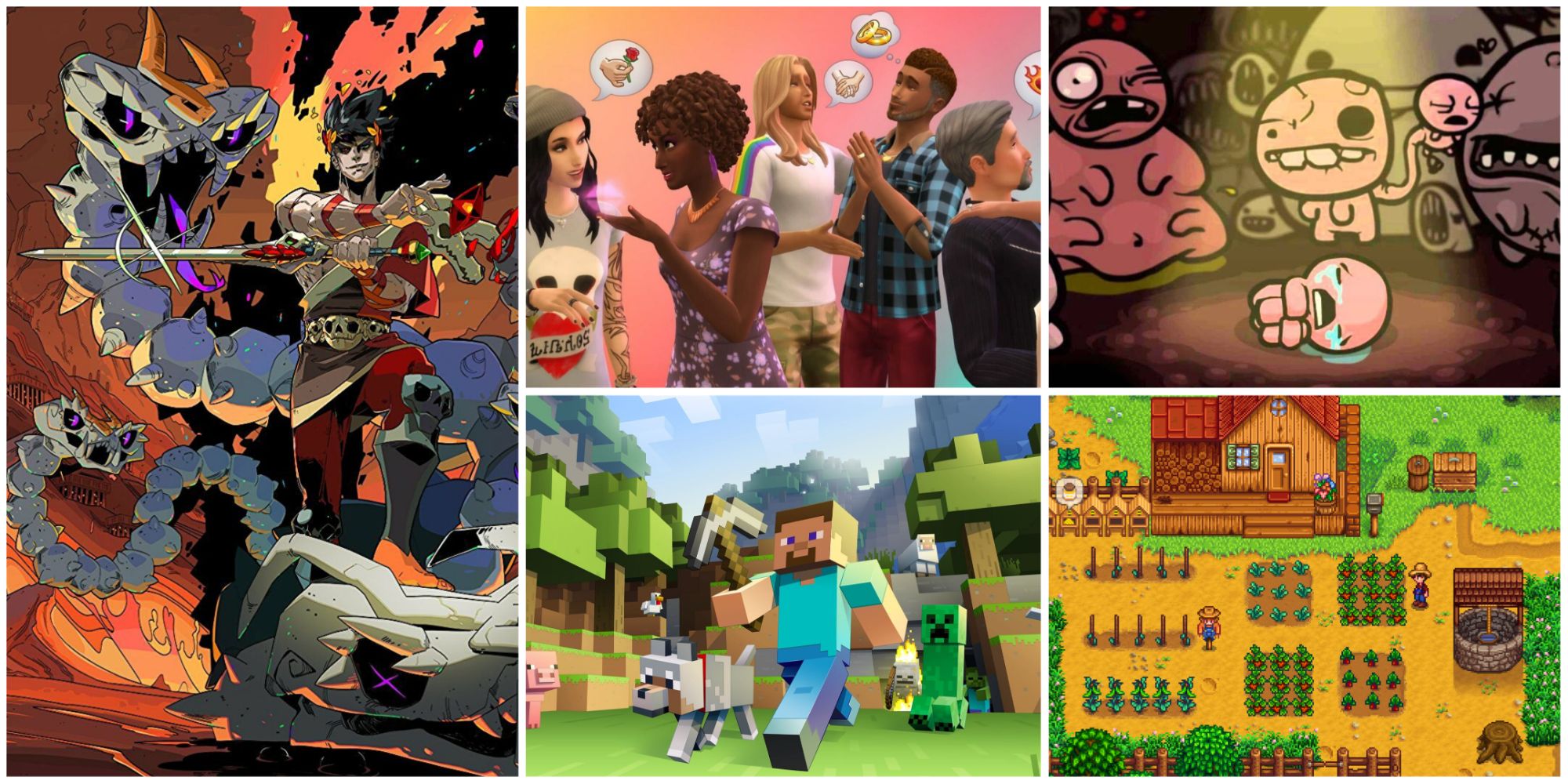Best Games with High Replayability and Addictive Gameplay: Exploring Endlessly Engaging Experiences
Best games with high replayability and addictive gameplay offer an irresistible allure that keeps players coming back for more. These games masterfully blend captivating mechanics, compelling content, and rewarding progression to create an immersive and unforgettable experience.
From the moment you dive into these captivating worlds, you’ll discover a depth and variety that ensures countless hours of entertainment. Each playthrough unveils new challenges, surprises, and opportunities for mastery, leaving you with an unquenchable thirst for more.
Introduction

Games with high replayability offer endless hours of entertainment, keeping players engaged and coming back for more. This type of game design is characterized by its ability to provide unique and engaging experiences that players can enjoy repeatedly without getting bored.Addictive gameplay, on the other hand, refers to games that captivate players and make them crave more.
These games typically incorporate elements that stimulate the brain’s reward system, creating a sense of accomplishment and satisfaction that drives players to continue playing.
Key Characteristics of Games with High Replayability
* Procedural generation:Games that generate unique levels or content on the fly, ensuring that each playthrough is different.
Randomized elements
Games that introduce elements of randomness, such as loot drops or enemy encounters, to keep players on their toes.
Multiple endings
Games that offer different outcomes based on player choices, encouraging multiple playthroughs to experience the full story.
High skill ceiling
Games that offer a challenging learning curve, allowing players to constantly improve their skills and strive for mastery.
Elements of Addictive Gameplay
* Positive reinforcement:Games that reward players for their actions, such as completing quests or defeating enemies, creating a sense of accomplishment.
Negative reinforcement
Games that punish players for making mistakes, such as losing progress or dying, motivating them to improve their performance.
Variable rewards
Games that offer unpredictable rewards, such as loot drops or power-ups, to keep players engaged and anticipating what’s next.
Sense of progression
Games that provide players with a clear sense of progress and achievement, motivating them to continue playing to reach the next level or unlock new abilities.
Factors Contributing to High Replayability
The concept of replayability in games encompasses the ability of a game to retain its appeal and engage players over extended periods. Multiple factors contribute to high replayability, ranging from the game’s mechanics to its content and reward systems.
Game Mechanics
Game mechanics play a pivotal role in fostering replayability. Mechanics that offer a wide range of strategic options, skill-based challenges, and emergent gameplay encourage players to revisit the game to explore different strategies and approaches. For instance, the turn-based strategy game Civilization offers a vast array of civilizations, each with unique strengths and weaknesses, enabling players to devise and execute diverse strategies.
Game Content
The depth and variety of game content directly impact replayability. Games that offer a substantial amount of content, such as expansive worlds to explore, diverse quests to complete, and customizable characters, provide players with ample opportunities for exploration and experimentation.
For example, the open-world RPG Skyrim boasts a massive world filled with intricate dungeons, side quests, and branching storylines, ensuring that players can engage with the game for hundreds of hours.
Player Progression and Rewards
Player progression and reward systems are essential for maintaining player engagement. Games that provide a sense of accomplishment and progression motivate players to continue playing. This can be achieved through level-up systems, skill trees, or the acquisition of in-game items and rewards.
The feeling of progression and reward encourages players to invest time and effort into the game, ultimately enhancing its replayability.
Genres and Examples of Highly Replayable Games: Best Games With High Replayability And Addictive Gameplay

Certain game genres naturally lend themselves to high replayability due to their inherent design features. These genres include:
Role-Playing Games (RPGs)
- Diablo III:An action RPG with an infinite loot system and procedurally generated dungeons, offering endless variations and challenges.
- The Elder Scrolls V: Skyrim:An open-world RPG with a vast world to explore, countless quests to complete, and character customization that allows for multiple playthroughs.
First-Person Shooters (FPS)
- Counter-Strike: Global Offensive:A competitive FPS with a dedicated player base, offering endless opportunities for skill development and strategic gameplay.
- Call of Duty: Warzone:A battle royale FPS with a constantly evolving map and gameplay mechanics, ensuring fresh and exciting experiences.
Strategy Games, Best games with high replayability and addictive gameplay
- Civilization VI:A turn-based strategy game with historical settings, offering a vast array of civilizations and playstyles.
- StarCraft II:A real-time strategy game with a thriving competitive scene and endless possibilities for creative gameplay.
Roguelikes and Roguelites
- Hades:A roguelike action RPG with a captivating story and challenging gameplay, encouraging multiple runs to unlock new content.
- Enter the Gungeon:A roguelike shooter with randomly generated levels and a vast arsenal of weapons, providing a unique experience each time.
Benefits of High Replayability
The allure of highly replayable games lies in their ability to provide sustained enjoyment and satisfaction for players. These games offer a level of depth and complexity that encourages multiple playthroughs, each with the potential for new experiences and discoveries.
One of the primary benefits of high replayability is the enhanced player enjoyment it brings. Games with a high degree of replayability allow players to explore different strategies, experiment with various character builds, and discover hidden secrets. This sense of exploration and discovery keeps players engaged and motivated to continue playing.
Positive Effects on Game Communities
Highly replayable games foster vibrant and active communities of players. These communities provide a platform for players to share strategies, discuss game mechanics, and connect with others who share their passion for the game. This social aspect enhances the overall gaming experience and encourages players to stay engaged with the game over the long term.
Impact on Game Longevity
Games with high replayability have a longer shelf life than those with limited replay value. Players are more likely to return to games they can replay multiple times, which extends the game’s lifespan and ensures a steady player base. This longevity benefits both players and developers, as it allows players to continue enjoying the game for an extended period and provides developers with a sustainable revenue stream.
Financial Implications
High replayability can have significant financial implications for game developers. Games with a high replay value tend to generate more revenue over time as players continue to purchase in-game items, expansions, and sequels. This sustained revenue stream provides developers with the resources to invest in further development and support for the game, creating a virtuous cycle that benefits both the developers and the players.
Challenges in Creating Highly Replayable Games

Crafting games with high replayability presents unique challenges for game designers. Balancing innovation with familiarity, ensuring depth without overwhelming complexity, and addressing player expectations are just a few of the obstacles that must be overcome.
Balancing Innovation and Familiarity
Incorporating innovative elements into gameplay is crucial for maintaining player engagement, but it must be done carefully. Introducing overly complex or unfamiliar mechanics can alienate players, while relying too heavily on familiar gameplay can lead to boredom. Designers must strike a delicate balance, introducing new challenges and rewards while respecting the core gameplay that made the game enjoyable in the first place.
Overcoming Complexity
Creating games with high replayability often involves introducing depth and complexity to the gameplay. However, it is essential to avoid overwhelming players with excessive complexity. Designers must carefully consider the learning curve, ensuring that new mechanics are introduced gradually and that players have ample opportunities to master them without feeling frustrated.
Meeting Player Expectations
Player expectations play a significant role in the success of highly replayable games. Designers must understand the target audience and their preferences, creating gameplay that aligns with their expectations while also surprising and engaging them. Meeting these expectations while introducing new and innovative elements is a challenging but essential task.
Best Practices for Overcoming Challenges
- Conduct thorough player research to understand their motivations and preferences.
- Iterate and test gameplay mechanics extensively, seeking feedback from players at various stages of development.
- Create a clear progression system that rewards players for their efforts and encourages them to continue playing.
li>Introduce new challenges and rewards gradually, ensuring that players have ample opportunities to learn and master new mechanics.
The Future of Highly Replayable Games
The future of highly replayable games is promising, with emerging trends in game design and advancements in technology set to enhance the player experience. As the gaming industry continues to evolve, developers are exploring innovative ways to create games that offer endless hours of entertainment.
Emerging Trends in Game Design
One notable trend is the increasing focus on player choice and customization. Games that allow players to tailor their experiences to their preferences are more likely to be replayed as players can explore different paths and outcomes. Procedural generation, where game content is randomly generated, also contributes to replayability by ensuring that each playthrough is unique.
Impact of Technology
Technological advancements are also shaping the future of replayable games. The rise of cloud gaming and streaming services enables players to access games on demand, removing barriers to entry and making it easier to replay their favorite titles. Virtual reality (VR) and augmented reality (AR) technologies are also creating immersive experiences that enhance replayability by transporting players into the game world.
Evolving Gamer Preferences
The evolving preferences of gamers are also influencing the design of highly replayable games. Players are increasingly seeking games that offer a sense of progression and reward, with in-game challenges and achievements that keep them engaged. Social features, such as multiplayer modes and online communities, also contribute to replayability by fostering a sense of connection and competition among players.
Epilogue

As the future of gaming unfolds, we can expect even more innovative and immersive experiences that push the boundaries of replayability. With advancements in technology and a deeper understanding of player preferences, developers will continue to craft games that captivate our imaginations and leave us craving for more.
So, embrace the thrill of endless replayability and immerse yourself in the captivating worlds of games that will keep you hooked for years to come.
Essential FAQs
What are the key elements of highly replayable games?
Highly replayable games often feature diverse content, deep progression systems, challenging gameplay loops, and social or competitive elements that encourage repeated playthroughs.
How do games achieve addictive gameplay?
Addictive gameplay typically involves a combination of rewarding mechanics, engaging challenges, and a sense of progression that keeps players motivated and invested in the experience.
What genres typically offer high replayability?
Genres such as RPGs, roguelikes, strategy games, and multiplayer games often lend themselves well to high replayability due to their inherent depth, variety, and social aspects.
